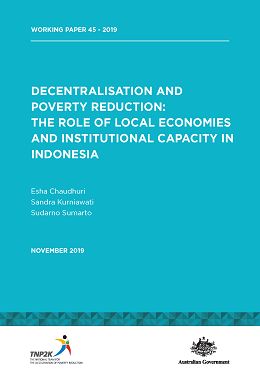Decentralisation And Poverty Reduction: The Role Of Local Economies And Institutional Capacity In Indonesia
Over the two decades to 2019, a decentralised Indonesia has made significant progress in reducing the poverty rate by more than 50 percent. Despite a significant decline at the national level, progress in poverty reduction has been uneven across districts. This study aims to investigate those factors that may explain these regional variations using panel regressions. Using district panel data set with annual observations from 2010 to 2016, we find that poverty reduction and regional economic output are strongly interrelated. We find that poverty tends to decrease more in districts with: (a) higher district economic output per capita; (b) higher outputs of manufacturing and service sectors; and (c) an active local office for the coordination of poverty reduction initiatives (Tim Koordinasi Penanggulangan Kemiskinan: TKPK). Poverty is also more likely to decrease in districts with: (a) a higher share of villages led by local leaders with a secondary education or higher; (b) higher educational attainment among the rural population; and (c) a higher share of villages with good road conditions. We find no correlation, however, between progress in poverty reduction and local government spending on education, health, and social protection. This suggests that simply increasing the amount of local government spending on social programs may not be effective in reducing poverty. Our findings also indicate that sufficient institutional capacity appears to be one of the critical preconditions for the delivery of more effective public services for poverty alleviation
